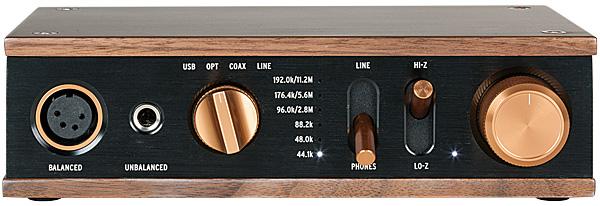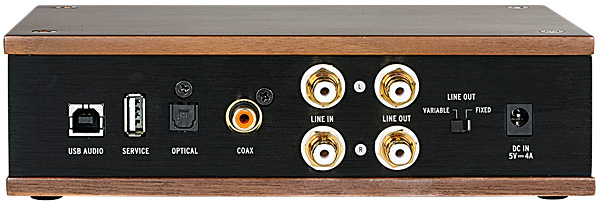Klipsch Heritage Headphone Amplifier headphone amp/DAC

 The companion to Klipsch's retro HP-3 headphones has similarly 'classic' styling – yet within the casework is a strikingly capable DAC/amp with an appeal beyond the brand
The companion to Klipsch's retro HP-3 headphones has similarly 'classic' styling – yet within the casework is a strikingly capable DAC/amp with an appeal beyond the brand
For some reason, one can't help but be reminded of those great American festive TV specials, usually called 'Home for the Holidays' or something similar, hosted by the likes of Andy Williams or Perry Como, and performed in a huge log-cabin set far up in the mountains of a Burbank backlot. You see, Klipsch has gone decidedly retro with its Heritage range, as noted in our review of its HP-3 headphones [HFN Nov '18], with a brochure liberally scattered with downhome images almost clamouring for a fine bourbon and an even finer cigar.
The Heritage Headphone Amplifier certainly fits the bill. Indeed, this £520 DAC/headphone amp/preamp even looks like someone made it using an old cigar box and some salvaged knobs and switches, thanks to those wooden top and bottom panels. Well, look a bit closer and you realise those trim panels are actually a high-quality walnut veneer rather than solid timber, but you get the general idea.
Tuning In To History
And that Heritage theme? Well, while Klipsch is a relative newcomer in the headphone-manufacturing world, the company justifies the label by saying that 'company founder Paul W Klipsch's first audio experimentation way back in 1919 was with a pair of headphones'.

More on that in our Log Cabin Listening sidebar, but it's clear that with this new range, Klipsch is working its history pretty hard, with styling as likely to divide opinion as fuel a warm nostalgic glow, the alloy and wood effect casework held in place by copper-coloured fixings. The wood isn't the only eye-catching element here, for the rotary input selector and main switchgear, finished to match the copper fixings and partnering HPA-3 headphones, have that air of having been salvaged from an old but purposeful radio set. However, what's under the lid of the Heritage Headphone Amplifier is decidedly less retro than its exterior, including digital-to-analogue conversion able to accept audio in file formats up to 192kHz/ 24-bit and DSD256/ 11.2MHz, depending on the input chosen. As well as both optical and coax digital ins, there's also a USB-Type B 'computer audio' connection, with the usual proviso that you'll need to download drivers to use the device with your Windows PC.
Digital inputs, and one analogue line source, are selected using that rotary switch on the front panel while a stack of LEDs beside it show the sampling rate being processed. The top three lamps double for 96kHz/DSD64, 176.4kHz/DSD128 and 192kHz/DSD256, illuminating white for a PCM input, and blue for DSD.
Gain, Set And Match
There's also a USB Type-A port round the back, but before anyone gets excited about plugging 'Sticks 'o' Tunes' (this retro thing is catching!) into it, the manual points out that it's there purely for service purposes. After all, the unit has no means of controlling and thus playing such music, as there's no remote control let alone a nifty smartphone app. What you see is what you get. And what you get extends to a volume control complete with a flipswitch beside it to allow you to up the amp's gain by 10dB [see PM's Lab Report]. This is curiously marked 'Hi-Z' for the boosted position and 'Low-Z' for normal, with the 'Z' obviously pronounced as 'zee' – though perhaps with all this nostalgia in the air Klipsch should have taken us all the way back to the days of watching Westerns in black and white and called the lower setting 'Lazy Z'.
Anyway, beside that sits another switch to select between the line and headphone output. This combines with a rear panel slider for fixed or variable output, and a pair of RCA analogue outs, to allow you to use the Heritage Headphone Amp either into a conventional amp or preamp, or directly into active speakers.
Headphone outputs? Klipsch provides a conventional 6.35mm socket and a balanced out on a four-pin XLR – which for some reason always seems more substantial and satisfying than the 2.5mm mini-jack on some rival designs. Power, meanwhile, comes from a universal offboard supply that, sadly, is not housed in wood with a cloth-covered braided cable to continue the nostalgic theme. A USB-A-to-USB-B cable is also included.
Under the lid the Heritage Headphone Amplifier is surprisingly busy, with an L-shaped board containing PSU filtering and regulation, the XMOS-based USB input and one of the seemingly ubiquitous ESS Sabre DACs – in this case an ES90128K2M – while the TI-sourced headphone amp is on its own board just behind the outputs.
And that's about it, beyond noting that the unit's power switch is as retro as the rest of the control hardware here, for as you turn the volume knob right down there's a click as the amplifier turns off – just like an old-style radio.
![]() Guts And Grip
Guts And Grip
While the nostalgic styling is obviously a major part of the appeal of this product, there's nothing old-fashioned about the performance on offer here. So while the glitzy effect of those bright copper-coloured controls may not be to every taste, this is no novelty product, but instead a very competent DAC/headphone amplifier dressed up in retro clothing.

























































